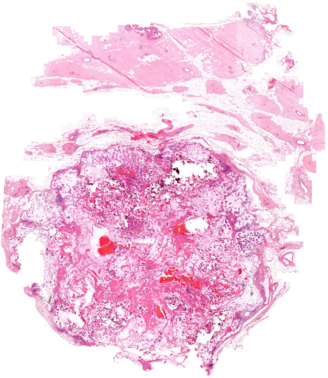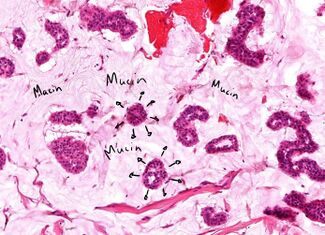42. Mucinous carcinoma: Difference between revisions
No edit summary |
No edit summary |
||
| Line 1: | Line 1: | ||
[[File:Mucinous carcinoma - overview.png|thumb|Overview]]''This slide is no longer part of the curriculum as of spring 2020, so you shouldn’t have to learn it.'' | [[File:Mucinous carcinoma - overview.png|thumb|Overview|378x378px]]''This slide is no longer part of the curriculum as of spring 2020, so you shouldn’t have to learn it.'' | ||
'''Staining''': HE | '''Staining''': HE | ||
| Line 16: | Line 16: | ||
* Usually older women | * Usually older women | ||
* Probably same as for other breast cancers[[File:Mucinous carcinoma - mucus.jpg|thumb|The arrows show the direction in which the tumor cells are secreting mucin]] | * Probably same as for other breast cancers[[File:Mucinous carcinoma - mucus.jpg|thumb|The arrows show the direction in which the tumor cells are secreting mucin|325x325px]] | ||
'''Theory''': | '''Theory''': | ||
Latest revision as of 14:43, 7 July 2024

This slide is no longer part of the curriculum as of spring 2020, so you shouldn’t have to learn it.
Staining: HE
Organ: Breast
Description:
The top of the slide shows normal breast tissue. The tumor is obvious.
The tumor cells form clusters that are “floating in a sea of mucin”. These tumor cells have lost their orientation and therefore secrete mucin outwards instead of inwards (into an acinus)
Diagnosis: Mucinous carcinoma
Risk factors:
- Usually older women
- Probably same as for other breast cancers

The arrows show the direction in which the tumor cells are secreting mucin
Theory:
Mucinous carcinoma is a rare type of breast carcinoma, accounting for less than 3% of cases. It has a better prognosis than invasive ductal carcinoma.
